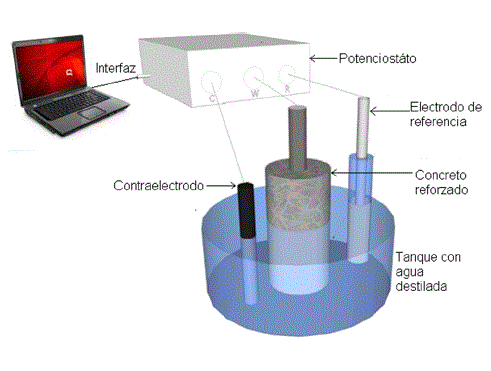Evaluación de la corrosión del acero embebido en concreto AAS, expuesto a carbonatación mediante un experimento factorial con medidas repetidas.
Main Article Content
Keywords
análisis de varianza, medida repetida, activación alcalina, carbonatación, corrosión.
Resumen
En este artículo se presentan las técnicas de evaluación de la corrosión, tales como potencial de corrosión, resistencia lineal a la polarización y pulso galvanostático a los concretos de activación alcalina (AAS) y Portland tipo I (OPC). El estudio se realizó por medio de modelos de análisis de varianza, aplicando un experimento factorial con tres factores, uno de ellos medida repetida, debido a que sobre la misma unidad experimental (concreto armado AAS y OPC) se ensayaron varias muestras para medirlas en el tiempo (0 h=1, 350 h=2, 700 h=3, 1050 h=4, 1700 h=5 y 2600 h=6), lo que hace que las observaciones no sean independientes; los otros dos factores corresponden al cementante (ce: 1=escoria activada alcalinamente [AAS] y 2=concreto Portland ordinario [OPC]) y la condición de exposición (ca: 1=exposición ambiente y 2=carbonatación acelerada), los cuales se discutieron en función de los resultados de las propiedades electroquímicas, donde se establecieron las diferencias en los materiales usados como recubrimiento del acero, concretos OPC y AAS. Los especímenes de concreto OPC exhibieron un potencial de reposo, y una resistencia de polarización y óhmica (condición CO2), superiores a los obtenidos en el concreto armado AAS.
PACS: 82.45.Bb
MSC: 62K15
Descargas
Referencias
[2] E. A. Sacco, J. D. Culcasi, C. I. Elsnera, and A. R. D. Sarlia., “Comportamiento en CNS de chapas de acero recubiertas por inmersión con Zn y aleación 55% Al-Zn, deformadas por tracción uniaxial.” in Jornadas SAM Conamet, 2001. 239
[3] D. M. Roy, W. Jiang, and M. R. Silsbee., “Chloride diffusion in ordinary, blended, and alkali-activated cement pastes and its relation to other properties,” Cement and Concrete Research, vol. 30, no. 12, pp. 1879–1884, 2000. 239
[4] J. Maldonado, R. D. Gutierrez, and S. Delvasto, “Propiedades de un subproducto industrial activado alcalinamente,” in VI Congreso Nacional de Corrosión, Bogotá, Colombia, 2001, pp. 1–5. 239
[5] D. Gaspar, “Seminario S.3: patología del hormigón, durabilidad (corrosión). X Curso de Estudios Mayores de la Construccion, Edificación, su Patología y Control de Calidad,” in Cemco 85, Madrid, España, 1985, pp. 205–210. 239
[6] N. I. Fattuhi and B. P. Hughes, “The performance of cement paste and concrete subjected to sulphuric acid attack,” Cement and Concrete Research, vol. 18, no. 1, pp. 545–553, 1988. 239
[7] Saraswathy and S. Ha-Won, “Evaluation of corrosion resistance of portland pozzolana cement and fly ash blended cements in pre-cracked reinforced concrete slabs under accelerated testing conditions,” Materials Chemistry and Physics, vol. 104, no. 2-3, pp. 356–361, 2007. 239
[8] S. Yodmunee and W. Yodsujai, “Study on corrosion of steel bar in fly ash based geopolymer concrete,” in International Conference on Pozzolan, Concrete and Geopolymer, Khon Kaen, Thailand, 2006, pp. 78–85. 240
[9] R. Kuehl, Diseños de experimentos: Principios estadísticos de diseño y análisis de investigación. I.T.P Latin America, México, 2001, no. 9706860487. 240
[10] ASTM, Test Method for Half-Cell Potentials of Uncoated Reinforcing Steel in Concrete, ASTM Standard C876- 09, American Society for Testing and Materials, 2010. 243
[11] P. Fernández, P. Livacic-Rojas, and G. Vallejo, “Cómo elegir la mejor prueba estadística para analizar un diseño de medidas repetidas,” International Journal of Clinical and Health Psyc, vol. 7, no. 1, pp. 153–175, 2007. 244
[12] F. Bellavance, S. Tardif, and M. A. Stephens, “Tests for the analysis of variance of crossover designs with correlated errors,” Biometrics, vol. 52, no. 2, pp. 607–612, 1996. 244
[13] A. R. Borzillo, J. E. Crowley, and J. B. Horton, “Non-ferrous metal coated products and method of production thereof. Bethlehem Steel Corporation,” 1989. 246
[14] A. Bentur, N. Berke, and S. Diamond., Steel Corrosion in Concrete: Fundamentals and civil engineering practice. E & FN Spon, 1997, no. 0419225307. 247
[15] N. M. Ihekwalva, B. B. Hope, and C. M. Hansson, “Pull-out and bond degradation of steel rebarsin ECE. Concrete,” Cement and Concrete Research, vol. 26, no. 2, pp. 267–282, 1996. 250
[16] D. W. Law, J. Cairns, S. G. Millard, and J. H. Bungey, “Measurement of loss of steel from reinforcing bars in concrete using linear polarisation resistance measurements,” NDT&E International, vol. 37, no. 5, pp. 381–388, 2004. 250
[17] S. Sathiyanarayanan, P. Natarajan, K. Saravanan, S. Srinivasan, and G. Venkatachari, “Corrosion monitoring of steel in concrete by galvanostatic pulse technique,” Cement and concrete composites, vol. 28, no. 7, pp. 630–637, 2006. 252
[18] B. Elsener, H. Wojtas, and H. Bohni, “Galvanostatic pulse measurements rapid on-site corrosion monitoring,” Proc. Inter. Conf. Corrosion and Corrosion Protecting of Steel in Concrete, vol. 1, no. 1, pp. 236–246, 1994. 252

